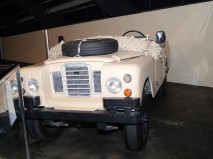1971 Land Rover Series 3 109
en.wikipedia.org
Production- 1971–1985
Predecessor - Land Rover Series IIA
Successor - Land Rover Defender
Body style - 2-door Off-road vehicle , 4-door Off-road vehicle, 2-door pickup
Engine - 2.25 L 73 hp (54 kW) I4 (Petrol)
2.25 L 62 hp (46 kW) I4 (Diesel)
2.6 L 86 hp (64 kW) I6 (Petrol)
3.5 L 91 hp (68 kW) V8 (Petrol)
Transmission - 4-speed manual main transmission, 2-speed manual transfer gearbox, Selectable 4-wheel drive
Wheelbase - 88.0 in (2,235 mm) (SWB)
109.0 in (2,769 mm) (LWB)
Length - 142.4 in (3,617 mm) (SWB)
175.0 in (4,445 mm) (LWB)
Width - 66.0 in (1,676 mm)
Height - 77.5 in (1,969 mm) (SWB)
81.0 in (2,057 mm) (LWB)
The Land Rover Series I, II, and III (commonly referred to as series Land Rovers, to distinguish them from later models) are off-road vehicles produced by the British manufacturer Land Rover that were inspired by the US-built Willys Jeep. In 1992, Land Rover claimed that 70% of all the vehicles they had built were still in use.
Series models feature leaf-sprung suspension with selectable two or four-wheel drive (4WD); though the Stage 1 V8 version of the Series III featured permanent 4WD. All three models could be started with a front hand crank and had the option of a rear power takeoff for accessories.
The Series III had the same body and engine options as the preceding IIa, including station wagons and the 1 Ton versions. Little changed cosmetically from the IIA to the Series III. The Series III is the most common Series vehicle, with 440,000 of the type built from 1971 to 1985. The headlights were moved to the wings on late production IIA models from 1968/9 onward (ostensibly to comply with Australian, American and Dutch lighting regulations) and remained in this position for the Series III. The traditional metal grille, featured on the Series I, II and IIA, was replaced with a plastic one for the Series III model. The 2.25-litre engine had its compression raised from 7:1 to 8:1, increasing the power slightly (the high compression engine had been an optional fit on the IIa model for several years). During the Series III production run from 1971 until 1985, the 1,000,000th Land Rover rolled off the production line in 1976. The Series III saw many changes in the later part of its life as Land Rover updated the design to meet increased competition. This was the first model to feature synchromesh on all four gears, although some late H-suffix SIIA models (mainly the more expensive Station Wagons) had used the all-synchro box. In keeping with early 1970s trends in automotive interior design, both in safety and use of more advanced materials, the simple metal dashboard of earlier models was redesigned to accept a new moulded plastic dash. The instrument cluster, which was previously centrally located, was moved to the driver's side. Long-wheelbase Series III vehicles had the Salisbury rear axle[clarification needed] as standard, although some late SIIA 109-inch (2,800 mm) vehicles had them too.






